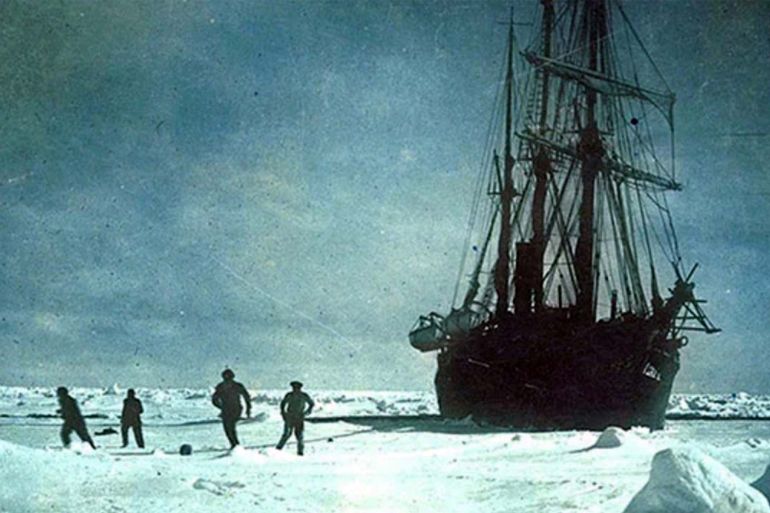At the bottom of the Weddell Sea, a team of scientists has discovered and photographed the greatest shipwreck ever discovered 107 years after the sinking of the lost ship Endurance commanded by Antarctic explorer Sir Ernest Shackleton.
The report, published by BBC News on 9 March, states that the ship had been wrecked by ice and sank in 1915, forcing its crew to abandon the ship and return spectacularly in small boats and on foot.
The video of the Endurance's remains shows that the ship is in perfect condition, and although it has been lying 3km underwater for more than a century, it looks just as it did the day it sank.
Excellent state of preservation
The ship's timber - although smashed - is still largely intact, and the name - Endurance - is clearly visible on the stern of the ship, and marine archaeologist Manson Pound, one of the members of the expedition that discovered the sunken ship, states that he has fulfilled the ambition of his 50-year career. "Without any exaggeration, this is the best wooden shipwreck I've ever seen," he told BBC News. "It's tall, on the sea floor, and in fantastic condition."
The project to find the missing ship was funded by the Falklands Maritime Heritage Trust/FMHT, using the South African Agulus II icebreaker, which is equipped with remotely operated submarines. The expedition leader described;
Polar geographer Dr. John Shears, the moment the cameras caught the ship's name as 'amazing'.
He added, "The discovery of the wreck is an amazing feat. We have successfully completed the world's most difficult shipwreck search, wading through ice, snow storms and temperatures as low as 18 degrees Celsius. We achieved what many said was impossible."
The Endurance was trapped in sea ice for months before it sank in the depths in 1915 (Getty Images)
Where did you find the ship?
Enduras were spotted in the Weddell Sea at a depth of 3,008 metres, as submarines combed a predetermined search area for more than two weeks, and various interesting targets were explored, before finally revealing the wreck site on Saturday, March 5, the centenary of Shackleton's funeral. The team spent the days following the discovery making a detailed photographic record of the ship and the surrounding area.
The wreck itself is a monument under the international Antarctic Treaty and should not be exposed in any way, so no physical artifacts have been brought to the surface.
The ship was found using the South African icebreaker Agulus 2 (Falkland Islands Maritime Heritage Trust and National Geographic)
What did the submarines pick up?
The ship looks very much as Frank Hurley, Shackleton's filmmaker, last photographed it in 1915. The ship had hit the bottom of the sea while it sank, the anchors are there, and the submariners have even spotted some shoes and crockery.
"You can even see the ship's name - ENDURANCE - on the stern just below the deck railing, and below that is the Polaris - the five-pointed star - which was the name of the ship in the original," Manson Pound told the BBC.
He added: "I tell you, you must be made of stone so that you don't get a little goosebumps when you see this star and the name above it, so you can see the skylight that is Shackleton's cabin. At that moment, you really feel the breath of the great man behind you."
What life forms were suspended on the ship?
Interestingly, the wreck has colonized many life forms - but not the kind that would harm them, and deep-sea polar biologist Dr Michelle Taylor of Essex University commented, "There appears to be a bit of damage in timber, which indicates that wood-eating animals found in other areas of our ocean are not found in the unforested Antarctic."
"The Endurance, which looks like a ghost ship, is filled with an impressive diversity of deep-sea marine life - sea sprays, anemones, sponges of various shapes, and sea stars, all fed by filters from the cool, deep waters of the Weddell Sea."
The final voyage of the Shackleton Endurance (BBC)
What is the significance of this ship?
The importance of the ship stems from two reasons;
The first is the story of Shackleton's interesting voyage across Antarctica, which set out to make the first crossing of Antarctica, but was forced to abandon the mission when trapped in the ice, and then somehow Shackleton managed to get his men to safety, where he boarded a small lifeboat across the seas ahead. for help.
The other reason was the challenge itself to find the ship. The Weddell Sea is permanently covered in thick sea ice, the same sea ice that tore the Endurance's body apart, and getting close to the supposed sinking site is incredibly difficult, not to mention being able to do a search.
Shackleton was buried at the Grytviken Whaling Station in South Georgia (Getty Images)
But that is also part of the success of the Falkland Islands Marine Heritage Fund project. Last month saw the lowest level of Antarctic sea ice ever recorded during the modern era, stretching back to the 1970s, meaning conditions were unexpectedly favourable.
The Agulhas completed its survey of the wreck and left the search site on Tuesday, and is now heading to its main port in Cape Town, intending to enter the British Overseas Territory in southern Georgia where Shackleton is buried.
"We're going to pay our respects to the president," says Dr. Shears, using the nickname the Endurance crew gave Shackleton.

